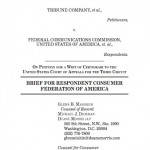A sample text widget
Etiam pulvinar consectetur dolor sed malesuada. Ut convallis
euismod dolor nec pretium. Nunc ut tristique massa.
Nam sodales mi vitae dolor ullamcorper et vulputate enim accumsan.
Morbi orci magna, tincidunt vitae molestie nec, molestie at mi. Nulla nulla lorem,
suscipit in posuere in, interdum non magna.
|

This is the brief I just prepared for the Consumer Federation of America to the U.S. Supreme Court on the issue of whether the so-called Red Lion doctrine of First Amendment regulation of broadcasters should be re-examined. My favorite passage is:
[T]he presumption of invalidity inherent in petitioners’ argument is flawed. Broadcasters do not remain “singularly constrained,” Pet. at 16, on the ground that there were few speakers 45 years ago. When Red Lion was decided there were hundreds more newspapers in America, half a dozen or more in major cities like New York, national, weekly news and cultural magazines (Life, Look, etc.) and many other sources of information and entertainment that are no longer available in today’s marketplace. Therefore, the “undeniably large increase in the number of broadcast stations and other media outlets” on which the D.C. Circuit and petitioners rely, id. at 18, is immaterial to the economic regulation of broadcast licensees unless — as petitioners dare not suggest, because it is untrue — the increase has lessened the technical need for governmental entry and interference regulation.
Whether there are three or six or ten television stations in a local market, however, does not at all mean there is enough spectrum to accommodate everyone who would like to use the airwaves. What some judges have called “the indefensible notion of spectrum scarcity,” Action For Children?’s Television v. FCC, 105 F.3d 723, 724 n.2 (D.C. Cir. 1997) (Edwards, J., dissenting), is therefore totally true and completely defensible.
[slideshare id=11925599&doc=11-696cfaopp-brief-120308132113-phpapp02&type=d]

More from the silly lawsuit department.
A federal court is being asked to grant constitutional rights to five killer whales that perform at marine parks — an unprecedented and quixotic legal action that is nonetheless “likely to stoke an ongoing, intense debate at America’s law schools over expansion of animal rights,” according to the Associated Press.
People for the Ethical Treatment of Animals (PETA) is accusing the SeaWorld marine parks of keeping five star-performer whales in conditions that violate the 13th Amendment’a ban on “slavery” and “involuntary servitude.” PETA relishes engaging in the court of public opinion, as evidenced by its provocative anti-fur and pro-vegan campaigns. Real courts are different, though.
Harvard Law School constitutional scholar Larry Tribe, while a supporter of animal rights, notes that “some Americans might find it bizarre or insulting to equate treatment of animals to the sufferings of human slavery.” SeaWorld Accused of Enslaving Killer Whales. Duh!
The original complaint, filed last October, alleged that
Section One of the Thirteenth Amendment prohibits the conditions of slavery and involuntary servitude without regard to the identity of the victim and without reference to “persons.” Although enacted in the historical context of African slavery, the Supreme Court has repeatedly declared that the Thirteenth Amendment is not so limited. Because the Amendment forbids any form of slavery, it embodies a principle that can be (and over the years has been) defined and expanded by common law to address morally unjust conditions of bondage and forced service existing anywhere in the United States.
“Slavery is slavery, and it does not depend on the species of the slave any more than it depends on gender, race or religion,” says general counsel to PETA, Jeffrey Kerr. Yet this overlooks the obvious issue that animals of all sorts, whether domesticated (like cattle and sheep), pets (dogs and cats) or zoological (lions, tigers and bears, oh my!) have since the founding of the United States been treated legally as property, i.e., “chattels.” And if unborn children in the womb have no independent legal existence — with which no one can argue, regardless of the legality of abortion — and minor children can be forced to work for their parents at home without pay, how in the world could the U.S. Constitution treat zoo specimens the same as black folks? Humans are different; that’s why we have laws, politics and a Constitution in the first place.
One does not have to be a PETA-basher to recognize that the “humane” treatment of animals is not at all the same as treating animals as humans.
P.S. SeaWorld filed a motion to dismiss on December 19, which is due to be heard by the federal court in San Diego on Feb, 12, 2012.

Whatever one thinks of Roger Clemens’ veracity (let alone possible steroid use), the idea that his criminal trial ends without a verdict because the prosecutors blatantly disregarded the court’s instructions by showing the jury inadmissible evidence is just astounding. Brings to mind former Supreme Court Justice Benjamin Cardozo’s famous question from the 1920s — should the suspect go free because the constable has blundered?
From the reports I’ve read, this was either incompetence or intentional overreaching, as the U.S. Attorneys’ office played in open court a videotape of congressional testimony in which a member read aloud portions of an affidavit (from Andy Petti’s wife) the court had declared — correctly, in my view — could not be used (at least not until rebuttal, if the defense attacked Pettit’s credibility). Astonishing. The meaning of this fiacso is that the government, no less and perhaps more than any other litigant, cannot under our American system of constitutional justice avoid its responsibilities to ensure fairness in criminal prosecutions.
Posted via email from glenn’s posterous.
It is rare that the justices of the Supreme Court of the United States actually write or speak about technology. But as connectivity and user-generated content become more ubiquitous and pervasive, sometimes the Court — despite its inherent judicial conservatism — just can’t avoid touching on issues related to the use, importance and legal status of modern communications technologies.
In that respect, the just-completed 2009-10 and 2010-11 Supreme Court terms witnessed two rather impressive developments. First, while more than a year ago most of the justices, and especially Antonin Scalia, said they had never even heard of Twitter, 2010 saw the first-ever mention of blogs and “social media” in a Supreme Court opinion, namely the controversial Citizens United decision on corporate campaign spending.
Rapid changes in technology — and the creative dynamic inherent in the concept of free expression — counsel against upholding a law that restricts political speech in certain media or by certain speakers. Today, 30-second television ads may be the most effective way to convey a political message. Soon, however, it may be that Internet sources, such as blogs and social networking Web sites, will provide citizens with significant information about political candidates and issues. Yet, §441b would seem to ban a blog post expressly advocating the election or defeat of a candidate if that blog were created with corporate funds. The First Amendment does not permit Congress to make these categorical distinctions based on the corporate identity of the speaker and the content of the political speech.
Citizens United v. FEC, 130 S. Ct. 876, slip op. at 49 (2010) (emphasis added; citations omitted).

Second, in this spring’s ruling overturning California’s regulation of violent video game sales to minor children — a/k/a teenage gamers — a sharply divided Court grappled not with the previously undecided question of whether video games merit First Amendment protection (on which there was unanimity), but instead the far narrower one of how to show a “compelling state interest” in restricting speech directed to children. That led to a remarkable passage, from Scalia himself, which as is typical was relegated to a footnote (where the “good stuff” is often found):
Justice Alito accuses us of pronouncing that playing violent video games “is not different in ‘kind’” from reading violent literature. Well of course it is different in kind, but not in a way that causes the provision and viewing of violent video games, unlike the provision and reading of books, not to be expressive activity and hence not to enjoy First Amendment protection. Reading Dante is unquestionably more cultured and intellectually edifying than playing Mortal Kombat. But these cultural and intellectual differences are not constitutional ones. Crudely violent video games, tawdry TV shows, and cheap novels and magazines are no less forms of speech than The Divine Comedy, and restrictions upon them must survive strict scrutiny—a question to which we devote our attention in Part III, infra. Even if we can see in them “nothing of any possible value to society . . ., they are as much entitled to the protection of free speech as the best of literature.” Winters v. New York, 333 U. S. 507, 510 (1948).
Brown v. Entertainment Merchants Assn., slip op. at 9 n.4 (2011) (emphasis added).
So the lesson is that although Justice Scalia may not know how to Tweet, but he can spell perfectly the name of a classic martial arts videogame, while still believing that The Divine Comedy is of greater value to society. What would the modern, technophile generation think about that? We’ll probably never know, because those facile with the means for mobile and rapid communications have short attention spans and thus probably lack have the patience (interest aside) to read Dante, even the Cliff Notes version, and tell us!
You may not agree with the Supreme Court’s denial of standing to plaintiffs challenging an Arizona law giving tax credits for parochial schools, but the sentiment of limited judicial powers articulated by Justice Kennedy should resonate with folks from Tea Party members to liberal activists. Supreme Court Upholds Tax Break for Arizona Religious Schools | L.A. Times.
Few exercises of the judicial power are more likely to undermine public confidence in the neutrality and integrity of the Judiciary than one which casts the Court in the role of a Council of Revision, conferring on itself the power to invalidate laws at the behest of anyone who disagrees with them. In an era of frequent litigation, class actions, sweeping injunctions with prospective effect, and continuing jurisdiction to enforce judicial remedies, courts must be more careful to insist on the formal rules of standing, not less so. Making the Article III standing inquiry all the more necessary are the significant implications of constitutional litigation, which can result in rules of wide applicability that are beyond Congress’ power to change. The present suit serves as an illustration of these principles.
Opinion at supremecourt.gov.

If you’re read my The Law of Social Media essays or presentations, you probably know there have been few serious cases yet establishing law specifically targeting social media. One can apply basic principles to predict what courts will do, but so far there are only a handful of reported decisions that say anything at all about social media.

That does not mean nothing happened in 2010 in this rapidly evolving area. In my view, the most important developments are reflected in these four cases:
1. The Food & Drug Administration’s citation of Novartis for Facebook content that lacked required pharmaceutical side-effect warnings and disclaimers, and the agency’s subsequent delay in release of social media “guidance” for pharma until Q1 2011. The case illustrates that heavily regulated industries face special risks and burdens in structuring social media marketing campaigns.
2. The assertion of jurisdiction by the National Labor Relations Board over “protected activity” of employees (discussing working conditions, for instance) on Facebook, even where the company is not unionized. This shows that, although equal employment issues still dominate employers’ use of social media in hiring and firing, there may be limits to which companies can penalize workers for their social media posts if the content is work-related.
3. The New Jersey Supreme Court’s decision in in Stengart v. Loving Care Agency, Inc., reversing the older, black-letter rule that employees have no privacy interests at all in employer-provided email systems.
4. The decision just days ago by the U.S. Court of Appeals for the 6th Circuit in United States v. Warshak, holding that the 20-year old Stored Communications Act’s approval of warrantless seizure by the government of user emails is unconstitutional under the Fourth Amendment. This is the first judicial opinion that extends “reasonable expectations of privacy” from snail mail and the telephone to email, using a principled and thoughtful constitutional analysis.
Since the advent of email, the telephone call and the letter have waned in importance, and an explosion of Internet-based communication has taken place. People are now able to send sensitive and intimate information, instantaneously, to friends, family, and colleagues half a world away. Lovers exchange sweet nothings, and businessmen swap ambitious plans, all with the click of a mouse button. Commerce has also taken hold in email. Online purchases are often documented in email accounts, and email is frequently used to remind patients and clients of imminent appointments.
In short, “account” is an apt word for the conglomeration of stored messages that comprises an email account, as it provides an account of its owner’s life. By obtaining access to someone’s email, government agents gain the ability to peer deeply into his activities. . . . If we accept that an email is analogous to a letter or a phone call, it is manifest that agents of the government cannot compel a commercial ISP to turn over the contents of an email without triggering the Fourth Amendment.
And as my friends at SiliconANGLE have observed, the same rationale should apply as well to emails stored in “the cloud” or other Web-based email systems, like Gmail and Hotmail.
* * * * * *
So there you have ’em. Not quite as interesting as the worst-dressed actress and best cinema films lists we’ll see over the next few days, but (perhaps) a bit more relevant to our daily activities on social networks and the real-time Web.
The outcry over federal judge Vaughn Walker’s decision overturning California’s Proposition 8 — which declared same-sex marriages unlawful — is hardly atypical where the Constitution is concerned. Why should a single judge, or nine (Supreme Court) judges, have the power to override the legitimate majority vote of citizens in a democracy?
The answer is that this is how it has always been in America. The constitutional checks and balances established by the Founding Fathers were intended to make the United States a republic; a political union in which the rights of those who are NOT in the majority are protected. That is why the Bill of Rights was added almost immediately after ratification of the Constitution. That is why the First Amendment protects the “free exercise” of religion from government control. Because in America, civil rights include the right not to be oppressed by the majority when essential liberties are concerned.
This is exactly how our constitutional democracy is supposed to work. Don’t blame federal judges for doing their jobs. The concept of judicial review has been at the core of our checks-and-balances democracy since the landmark Marbury vs. Madison ruling in 1803.
The Pro9 8 Decision—One Judge vs. 7 Million Voters? | SF Chronicle.
One can disagree with whether morality is a valid basis for legislation outlawing certain behavior. Constitutional law is split, with some decisions, like the 2003 case in which the Supreme Court overturned criminalization of consensual sodomy, indicating that moral values cannot trump individual rights. That rationale, of course, could also be extended to a variety of issues — from abortion to alcohol to public sex or nudity — in which only the sensibilities of others are affected.
The difference here is that, under the law as it stands now, legislation must have a secular purpose to survive constitutional challenge. The proponents of Prop 8 argued only that the initiative was intended to further society’s interest in procreation, that is child-bearing. But if that were the case, Judge Walker cogently explained, then fertility should be a precondition to traditional marriage, and couples unable to conceive or not wanting children would be barred from marrying. Not so long ago, interracial marriages were also unlawful. The outcry against the 1967 Supreme Court decision striking down such laws subsided rather quickly, and in my view that’s a good thing.
As if to prove Walker’s point, Los Angeles Cardinal Roger Mahony released a statement on Wednesday that said, “Those of us who supported Prop 8 and worked for its passage did so for one reason: We truly believe that marriage was instituted by God for the specific purpose of carrying out God’s plan for the world and human society. Period.”
Why the Prop 8 Rung Scares Religious Conservatives | NewsOK
200 years ago slavery was accepted and written into the Constitution. The Fourteenth Amendment changed all that after the Dred Scott decision declared that slaves were property and not citizens. It took a long and brutal civil war to make the leap, but America was and is better off. Whether or not you agree that gay marriage should be constitutionally protected, the system of judicial review is quintessentially American and something to be celebrated.
Yesterday a federal district judge ruled the “National Day of Prayer” unconstitutional. But observing such a commemorative occasion involved no compulsion, discrimination or penalty on or against any observer of any religious doctrine. So what’s the rub?
Lots of Americans realize the First Amendment protects freedom of religion. It actually has two parts. The 1st guarantees the “free exercise” of religious beliefs. The 2nd prohibits any “establishment of religion” by the government. It’s the second clause — known unoriginally as the “establishment clause” — that is in play when debating invocations at public events, schools and the like.
“A determination that the government may not endorse a religious message is not a determination that the message itself is harmful, unimportant, or undeserving of dissemination,” she said. “Rather it is part of the effort to carry out the Founders’ plan of preserving religious liberty to the fullest extent possible in a pluralistic society.”
Personally I think there’s a difference between making all elementary school students recite the Lord’s Prayer and ordaining a national day, really just an honorific, to recognize the role of prayer in American society. The former was declared unconstitutional in the early 1960s and few citizens today would object to that significant step toward religious tolerance and diversity. But as a constitutional matter, it is simply not the case that the US Constitution’s protections for religious freedom mean the government can support or promote either specific denominations (e.g., Anglicans over Baptists) or movements (e.g., Christianity over all the rest). At the margin, things like a National Prayer Day have little relevance except to those who stand on principle and refuse to compromise, which in US constitutional jurisprudence has always been a discrete and insular minority.

The U.S. Supreme Court, for the first time, took note of social media today, observing that “soon … it may be that Internet sources, such as blogs and social networking Web sites, will provide citizens with significant information about political candidates and issues.”
This landmark event occurred in Citizens United v. FEC, a case overturning the McCain-Feingold 2002 campaign reform legislation which required corporations to fund “electioneering communications” through PACs. Supreme Court Removes Limits on Corporate, Labor Donations to Campaigns [Fox]. So get ready to see explicit corporate-funded movies, TV spots, Twitter campaigns and Facebook fan pages furthering their political views every November.

Whether that is good or bad for American democracy I will leave to readers’ own judgments.
Rapid changes in technology—and the creative dynamic inherent in the concept of free expression—counsel against upholding a law that restricts political speech in certain media or by certain speakers. See Part II–C, supra. Today, 30-second television ads may be the most effective way to convey a political message. See McConnell, supra, at 261 (opinion of SCALIA, J.). Soon, however, it may be that Internet sources, such as blogs and social networking Web sites, will provide citizens with significant informa- tion about political candidates and issues. Yet, §441b would seem to ban a blog post expressly advocating the election or defeat of a candidate if that blog were created with corporate funds. See 2 U. S. C. §441b(a); MCFL, supra, at 249. The First Amendment does not permit Congress to make these categorical distinctions based on the corporate identity of the speaker and the content of the political speech.
Speech is indeed effectively free in the age of YouTube. So that does undermine the scarcity argument traditionally used for the (now-defunct) “fairness doctrine” and the like. But some conservative pundits, like Gordon Crovitz in the Wall Street Journal today, argue this makes political campaign contribution limits both obsolete and unconstitutional. Why Campaign Political Speech Restrictions on Unions and Corporations Make No Sense [WSJ.com].
The problem is that while speech is free, campaign $$ is not. Crovitz equates money with political speech, something the Supreme Court did (erroneously in my view) way back in the 1970s in upholding some, but not all, Watergate-era campaign spending and contribution limits. That does not mean, as he implies, that restricting corporate political contributions is “silly,” because Cravitz’s own analysis shows that it is communication where technology has leveled the playing field, not political campaigns, with all their expensive pre-Web 2.0 trappings like air travel, rally planing and event staging.
In his defense, what Crovitz appears to be saying is that bans on pure corporate political speech, rather than monetary contributions, are problematic:
Whatever the arguments for blocking direct contributions by corporations and unions, McCain-Feingold goes beyond this and directly limits First Amendment speech. The Constitution doesn’t promise “equal” speech, just the freedom to speak.
I agree with that. But the premise that “direct contributions” are different should be the start, not a footnote, to this debate.
|
|








